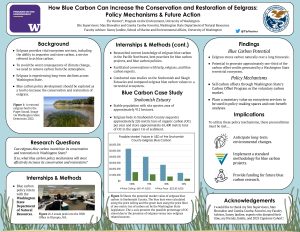HOW BLUE CARBON CAN INCREASE THE CONSERVATION AND RESTORATION OF EELGRASS
As the global environment deteriorates, we have begun to realize the value of ecosystem services. Kelp and Eelgrass are important nearshore ecosystems whose ability to sequester and store carbon, or blue carbon potential, can incentivize their protection to maximize the ecosystem services they provide. The aim of this study was to understand what actions and policy mechanisms could be implemented to maximize the protection of kelp and eelgrass based on their blue carbon potential. During my internship, I worked with the Washington State Department of Natural Resources to compile current information on kelp and eelgrass blue carbon in the Pacific Northwest. For my research, I synthesized scholarly publications, conducted conversations with experts, and developed blue carbon case studies on the Skagit and Snohomish Estuaries. I found that kelp’s blue carbon potential is highest under aquaculture with active human intervention. Yet, eelgrass ecosystems have blue carbon potential that can be increased by conservation and restoration alone. Therefore, policy solutions include the monetary valuation of the blue carbon potential of eelgrass ecosystems to be used in cost-benefit analyses or as carbon offset credits in the carbon market to develop revenue. With increased conservation and restoration of eelgrass ecosystems, not only will climate change be mitigated, but many ecosystem co-benefits will be provided, such as climate adaptation, vital habitats for culturally and commercially important species, erosion prevention, and more. If revenue is generated through the carbon market, the Department of Natural Resources can reinvest in Washington State communities or further conservation and restoration.
